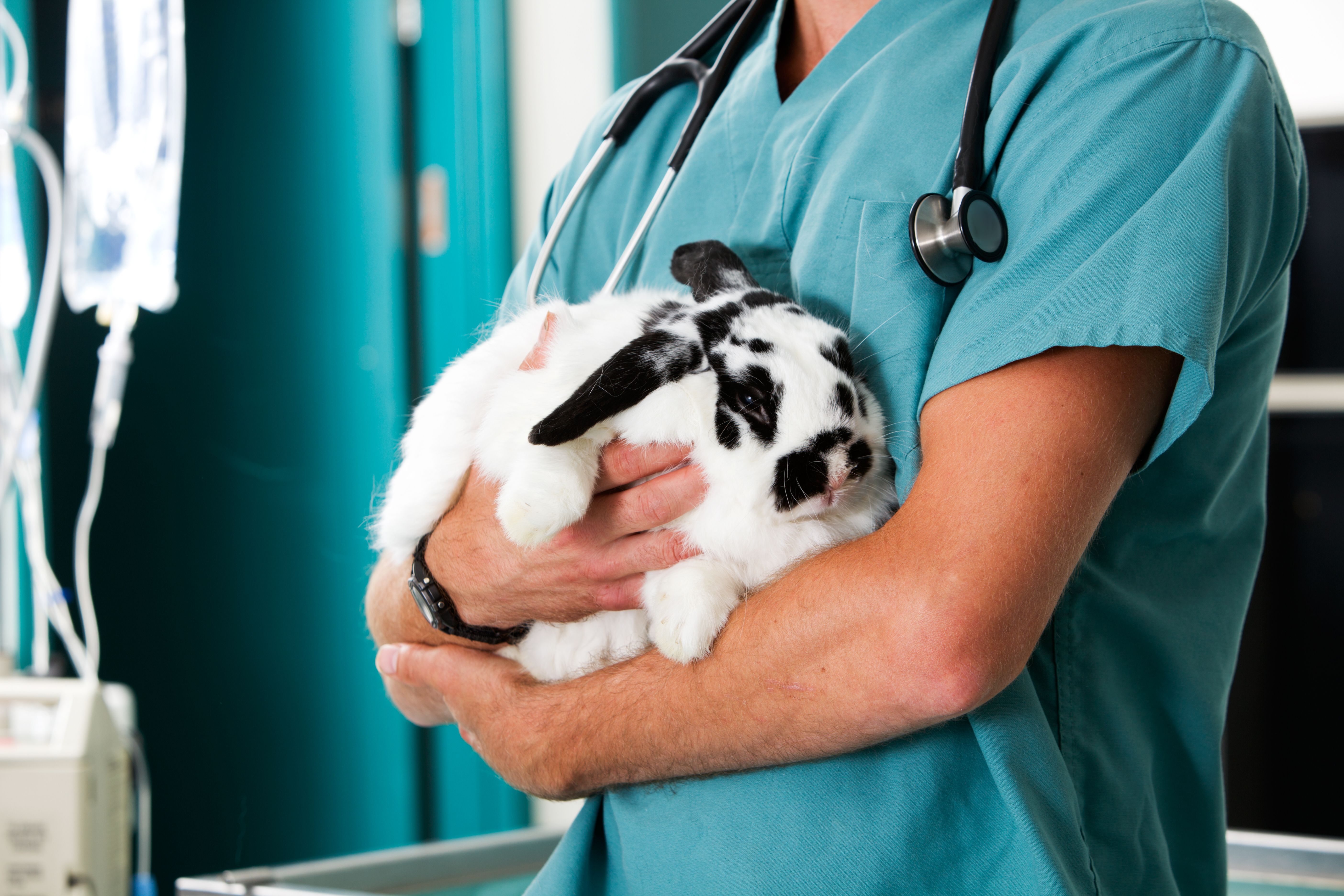Rabbit endotracheal intubation: Yes, you can do it (Part 1)
An expert demystifies rabbit intubation to ensure these animals can receive the same standard of care as cats and dogs
Rabbit endotracheal intubation can be scary and challenging. However, what if I told you it is easier than you think? What if I told you the only thing preventing you from doing it is the lack of a proper tool?
If you are reading this article, chances are you are seeking a solution to a problem you already have. You want to stop losing rabbits during anesthesia. That feeling in your stomach when the nurse tells you the rabbit stopped breathing is overwhelming. Having to tell the client their pet just passed away and you are not sure what happened is soul crushing. It makes you want to give up.
Tyler Olson / stock.adobe.com

I am here to show you a different perspective, in hopes that you will see a solution to your problem, one that will enable you to persist with your passion for rabbit medicine and surgery. After all, we all deserve to do what makes us happy. However, there will be a little bit of tough love first.
First things first: We need to agree that endotracheal intubation should always be the standard of care. Not intubating a rabbit patient, in my opinion, is substandard medicine, and I would even go as far as to call it malpractice. I know, it sounds harsh, but you too know it to be true.
Let’s engage in a quick exercise that will allow you to see my point of view. Let’s change the word “rabbit” to the word “dog.” Imagine this was an article about anesthetizing a female dog for a spay, and I tried to convince you that anesthesia would be faster and easier if you just “masked the dog down” instead of taking the time to secure an airway with an endotracheal tube. “Don’t worry about intubation; dogs are known for dying under anesthesia; it is to be expected.” How would you react to that? Would you agree with me and proceed, or would you start writing a letter to the editor immediately, stating how absurd it is to have a publication recommending such a careless procedure?
Inhalant anesthesia (eg, isoflurane) is known to be hypotensive as anesthesia duration increases. We also know that ventilation will be compromised with anesthesia and positioning, even if the patient is breathing voluntarily, and will inadvertently lead to hypercapnia and hypoxemia. It is a known recipe for disaster, and we still engage in it. I will be the first to admit I have done it for years, and for years I blamed the species “rabbit” instead of my lack of skills, not to mention the health hazard of having environmental inhalant gas contamination. It didn’t even cross my mind that I could be the culprit until I lost a young rabbit during an orchiectomy. This was the way I had seen it done every time by really experienced colleagues. I was just repeating something without questioning it, even in the face of bad outcomes. The point is, it is not the rabbit’s fault—it is our naivety in expecting a different outcome. I am also not here trying to convince you that intubating rabbits is as easy as intubating dogs. There is a learning curve, and you do need additional equipment. However, I am here to tell you it is a short learning curve, and the lack of clinical skills should not be a reason to compromise patient care.
Last, but not least, there are other variables that will dictate the success of the anesthesia, such as having intravenous access; the use of multimodal anesthesia, including constant rate infusions to reduce isoflurane minimum alveolar concentration;1-3 heat support; and adequate premedication. Success will also depend on monitoring, including blood pressure, temperature, electrocardiogram (ECG), endtidal carbon dioxide, and partial pressure
of oxygen.
Now that we have established that rabbit endotracheal intubation is possible, let’s examine some key considerations.
General considerations (do not skip any steps)
To ensure the procedure is successful, always have all equipment ready to go and make sure you have all emergency drugs and reversals calculated—consider having glycopyrrolate, epinephrine, and reversals in predrawn syringes. Heavy sedation is highly recommended and will allow smooth placement of an intravenous catheter and less reliance on induction agents and inhalant anesthesia. Provide preoxygenation, because it reduces the risk of hemoglobin desaturation and hypoxemia during the induction process.4 Always connect the patient to monitoring devices prior to intubation (eg, ECG, pulse oximeter), and have a designated person to monitor anesthesia during intubation. That person should not be doing anything else but monitoring the patient: no fetching syringes, no holding the patient. They do nothing but monitoring.
Make sure to provide proper induction of general anesthesia. This is by far one of the main reasons people have difficulty intubating. Many challenges come from a patient that is not appropriately induced (too light) and is therefore chewing and moving, and with a strong jaw tone. For this technique to work, jaw tone needs to be absent, which means in your choice of induction agent you need to take this into account. “Masking a patient down” with inhalants, as we have previously discussed, is not an appropriate induction method and will not allow proper time for intubation, especially for the untrained clinician.
I understand there is a concern about inducing the patient properly, because there is an innate risk of apnea, and we are afraid we will not be able to intubate on time or intubate at all. The solution to this problem is simple: Always have the rabbit supraglottic airway devices available in all sizes. Those are good to have as a crutch. They are simple to place and allow you to properly ventilate the patient.5 They will not replace endotracheal intubation in all circumstances and can be difficult to maintain in place depending on the procedure. Therefore, it is still paramount that one becomes comfortable with intubating a rabbit patient.
On that note, it is important to highlight the need for capnography. This is the most important tool to guarantee you have properly intubated your patient, and to monitor carbon dioxide levels during the procedure. Just because a patient is breathing on their own, it does not mean they are ventilating properly, and you might need to breathe for them in cases of hypercapnia, which will allow you to have an uneventful anesthesia. In addition, when using a supraglottic airway device, capnography is a must. No skipping steps here.
Lastly, I want to cover some aspects that might make you nervous in the beginning. Don’t pressure yourself to intubate in a few seconds, or even in less than a minute. If you are following all the steps and the patient is being prop- erly monitored, you have some time. When you take a bit longer to intubate, your team might just need to repeat the induction agent titrating to effect; don’t be afraid to fail on your first attempts to intubate. I was not able to intubate the first 3 rabbits on my own. It is a learning curve for everybody and it will not be different for you. Expect failure, while guaranteeing patient safety, and do not give up.
Don’t be so afraid of laryngospasms if you are following the technique as described here. As long as you are being delicate and seeing what you are doing (we will discuss the use of an endoscope later), you should be fine. Because you can see the larynx at all times, you will be able to tell if it is becoming inflamed or edematous. Lidocaine sprayed on the larynx will also help with that.
Don’t be afraid to abort the procedure. We always pressure ourselves so much with being perfect and not failing. It is OK to abort the procedure if you must. Patient safety comes first. In the beginning, I always had this conversation in advance with the owners. Set up expectations and you will not have issues.
Finally, practice on cadavers first. The learning curve to using the equipment can be completely addressed in cadavers. That way, you will be confident and comfortable with the equipment when you have a real patient. Cadavers can be purchased (preferably from sources that acquire cadavers that were euthanized in shelters or different institutions), or you can request permission from owners when you have an euthanasia case. Set yourself up for success. Practice as much as you can on the cadavers. Become familiar with your landmarks, positioning the patient, and handling and using the scope. With all of that in place, you will be more confident and less anxious when intubating your patients.
Learning the technique (part 2)
I have laid out the reasoning and considerations for learning rabbit endotracheal intubation. Stay tuned for part 2 in an upcoming issue, in which we will discuss the technique, equipment, and process.
Founder and CEO of VETAHEAD, Laila Proença, DVM, PhD, MV, MSc, DACZM, has always been passionate about veterinary medicine. She is the first South American veterinarian to become a diplomate of the American College of Zoological Medicine, with an emphasis on zoological companion animals. She is coeditor of the 2015 exotic endoscopy issue of Veterinary Clinics of North America: Small Animal Practice, and has been actively participating in the zoological medicine community, leading wet labs and giving national and international lectures, courses (including on endoscopy), and masterclasses.
References
- Barter LS, Hawkins MG, Pypendop BH. Effects of fentanyl on isoflurane minimum alveolar concentration in New Zealand White rabbits (Oryctolagus cuniculus). Am J Vet Res. 2015;76(2):111-115. doi:10.2460/ajvr.76.2.111
- Schnellbacher RW, Carpenter JW, Mason DE, KuKanich B, Beaufrère H, Boysen C. Effects of lidocaine administration via continuous rate infusion on the minimum alveolar concentration of isoflurane in New Zealand White rabbits (Oryctolagus cuniculus). Am J Vet Res. 2013;74(11):1377-1384. doi:10.2460/ajvr.74.11.1377
- Tearney CC, Barter LS, Pypendop BH. Cardiovascular effects of equipotent doses of isoflurane alone and isoflurane plus fentanyl in New Zealand White rabbits (Oryctolagus cuniculus). Am J Vet Res. 2015;76(7):591-598. doi:10.2460/ajvr.76.7.591
- Johnson DH. Endoscopic intubation of exotic companion mammals. Vet Clin North Am Exot Anim Pract. 2010;13(2):273-289. doi:10.1016/j.cvex.2010.01.010
- Comolli J, Schnellbacher R, Beaufrere H, et al. Comparison of endoscopic endotracheal intubation and the v-gel supraglottic airway device for spontaneously ventilating New Zealand White rabbits undergoing ovariohysterectomy. Vet Rec. 2020;187(10):e84. doi:10.1136/vr.105746
